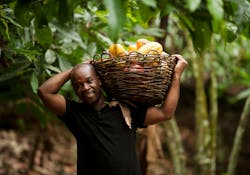Fairtrade Announces New Minimum Price For Cocoa, Establishes Living Income Benchmarks
Washington, DC, Jan. 18, 2019 (GLOBE NEWSWIRE) -- Fairtrade is raising the Minimum Price and Premium for Fairtrade cocoa with the aim of improving conditions for cocoa farmers and their families. In addition, Fairtrade has established a first-ever Living Income Reference Price for cocoa in the Ivory Coast and Ghana, the world’s largest cocoa-producing countries. The decision follows an in-depth consultation process across the cocoa supply chain with Fairtrade farmers, traders, manufacturers, and chocolate brands.
Last year, world cocoa prices plunged by more than a third with farmers bearing the brunt of that price volatility. Fairtrade is the only certification scheme that has a mandatory minimum price, which provides a safety net for farmers when market prices fall. Additionally, the Fairtrade Premium, an additional amount paid by companies above the purchase price, provides farmer organizations with funds to invest in their businesses and communities according to their priorities.
“The increased Minimum Price and Premium are much needed, but we are also innovating the Fairtrade approach to create a path toward a living income,” said Bryan Lew, Chief Operating Officer of Fairtrade America. “These new benchmarks will give companies the information they need to improve their practices and improve farmer livelihoods beyond the minimum requirements.”
The Fairtrade Minimum Price for conventional cocoa was raised from $2,000 to $2,400 per metric ton, marking a 20 percent increase. For organically-farmed cocoa, the Fairtrade Minimum Price will be $2,700. The Fairtrade Premium will be increased from $200 to $240 per metric ton, the highest fixed premium of any certification. In 2017, Fairtrade cocoa farmer cooperatives earned nearly $43 million in Fairtrade Premium to invest in their communities and businesses. The new price structure will take effect on October 1, 2019.
Companies purchasing cocoa on Fairtrade terms are required to pay at least the Minimum Price and Premium in addition to complying with the sourcing and transparency requirements outlined in the Fairtrade Standards. When market indicator prices are higher than the Fairtrade minimum, farmers can negotiate for higher prices. As part of Fairtrade’s approach, farmers’ organizations are required to meet rigorous social, environmental and economic standards.
“This is good news for West Africa’s cocoa-growing communities,” said Fortin Bley, an Ivorian cocoa farmer and chairperson of Fairtrade Africa’s West African Network. “Farmers have been badly squeezed by low world prices, so the higher Fairtrade Minimum Price and Premium help to level the playing field for a more sustainable future.”
New Living Income Reference Price sets target level
Fairtrade also introduced a new living income reference price. The pricing changes are linked to a wider strategy to help farmers progress toward a living income. The new Living Income Reference Price for cocoa in Ivory Coast and Ghana is the first target price based on living income benchmarks and real farm costs.
Unlike the Fairtrade Minimum Price, the Living Income Reference Price is not mandatory. Fairtrade will develop projects with committed partners to test the Fairtrade Living Income Strategy, including price and diversification initiatives, and share learning that will move the cocoa industry closer to supporting a living income.For more information on the new policies, click here.
About Fairtrade America
Fairtrade America represents Fairtrade International in the United States. The Fairtrade label, licensed by Fairtrade America, is the most recognized and trusted ethical certification worldwide. By complying with the rigorous social, economic and environmental criteria in the internationally-agreed Fairtrade Standards, farmers, traders and brands can improve the sustainability of their entire supply chain. There are currently more than 1.6 million farmers and workers in certified organizations across 75 countries. The Fairtrade label appears on more than 30,000 products sold in over 150 countries. Visit www.fairtradeamerica.org to learn more.
